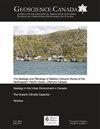纪念Gerard V.Middleton的研讨会:GeoConvention,卡尔加里,2022年6月21日
IF 0.8
4区 地球科学
Q3 GEOSCIENCES, MULTIDISCIPLINARY
引用次数: 0
摘要
杰拉德·米德尔顿,麦克马斯特大学名誉教授,于2021年11月2日去世,享年90岁。格里(Gerry)是加拿大第一批“自认为”是沉积学家的地质学家之一,尽管他的职业生涯是从研究泥盆纪碳酸盐沉积物的古生物学家开始的。1955年,他来到麦克马斯特大学,很快就转向了沉积地球化学,然后又转向了碎屑沉积过程的研究,这一领域在当时可以说还没有达到起步阶段。在20世纪60年代和70年代,Gerry在我们对沉积物运输的理解以及水动力沉积结构和沉积物重力流(Gerry创造的术语)的识别、分类和解释方面取得了根本性的进展。格里于1996年退休,在当时的编辑罗杰·麦奎因(Roger Macqueen)的编辑下,本刊的特刊(第24期,1997年第1期)专门纪念了他作为研究者、作者和编辑的一生贡献。Gerard的职业生涯和他对加拿大地球科学进步的重大贡献也在Bob Dalrymple和Janok Bhattacharya(2021)发表在《加拿大地球科学》上的讣告中得到了专业的总结。现在,我们有了一定的视角来回顾格里对沉积学的贡献,并评估其重要性。公平地说,在我们对碎屑沉积过程的理解中,他是几个最基本突破的核心。GeoConvention 2022研讨会旨在关注这些发展,以及基于他的研究、他以前的学生和同事以及其他从他的长期影响中受益的人所取得的进展。Dalrymple和Bhattacharya(2021)巧妙地总结了他对加拿大地球科学生活和工作的许多其他贡献。麻省理工学院(MIT)的约翰•索萨德(John Southard)受邀在他的办公室通过Zoom向研讨会致开幕词。他个人对与Gerry一起工作的回忆,以及他们在沉积水力学领域发起的研究,帮助我们对该领域的历史和发展进行了展望,我们很喜欢两位富有成效的研究人员的个人故事,他们共同努力,创造了一个全新的沉积学领域。一个真正成功的研究教授是一个能够激励学生的人,在这次研讨会上的几位演讲者(Dalrymple, Bhattacharya, Plint, Leckie和Arnott)有幸成为20世纪70年代由Gerry和他的同事Roger Walker领导的麦克马斯特沉积学“学院”的大批学生中的一员。达尔林普尔由格里监督;沃克的《巴塔查里亚与莱基》;普林特是罗杰·沃克的博士后研究员,阿诺特是本科生。在至少20年的时间里,也就是20世纪70年代和80年代,米德尔顿-沃克学院可以说是研究沉积地质学的两个真正“世界级”(一个被过度使用的术语)的地方之一;它唯一真正的竞争对手牛津大学由哈罗德·雷丁领导这本杂志的读者不需要提醒,著名的“相模型”卷的惊人成功是米德尔顿和沃克合作工作的结果。Gerry过去喜欢提醒观众,尽管Walker是“相模型”项目的创始人和编辑,但正是他Gerry编写了第一本关于相模型的教科书摘要,并出现在1972年出版的Blatt, Middleton和Murray教科书的第一版中。不一定要成为一个研究小组的正式成员才能受益于它的影响。就我而言,作为加拿大地质调查局(Geological Survey of Canada)的研究科学家,我从遥远的卡尔加里开始意识到麦克马斯特大学(McMaster University)的重要性,并于1975年第一次以研讨会演讲者的身份访问了那里。后来,我在1982年格里代表国际沉积学家协会在麦克马斯特大学组织并主持的沉积学大会上担任项目主席。在此期间,我担任了几个麦克马斯特大学博士委员会的研究生导师或考官,并且一直很重视我对团队的参与。另外两位发言者,贝尔和恩格勒,代表了一个庞大的研究群体,他们的科学最终源于格里开创的进步,通过他的继任者和世界各地的同事进行的大量工作。沉积物重力流和海底扇以及浊积岩系统的研究在20世纪80年代爆发,这主要是由于海底声纳方法的广泛使用和先进的海底取心技术,以及深水沉积物作为石油储集层的重要性日益增加。但米德尔顿的主要贡献,尤其是他的第49卷,2022卷,227卷本文章由计算机程序翻译,如有差异,请以英文原文为准。
A Symposium in Honour of Gerard V. Middleton: GeoConvention, Calgary, June 21, 2022
Gerard Middleton, Emeritus Professor at McMaster University, passed away on 2nd November 2021 at the age of 90. Gerry, as he was happy to be called, was one of the first geologists in Canada to “self-identify” as a sedimentologist, although he started his career as a paleontologist working on Devonian carbonate sediments. He arrived at McMaster University in 1955, and soon switched to sedimentary geochemistry, and then to the study of clastic sedimentary processes, a field that, at that time, could be said to have not even reached the stage of infancy. In the 1960s and 1970s Gerry made fundamental advances in our understanding of sediment transport and the identification, classification and interpretation of hydrodynamic sedimentary structures and sediment gravity flows (a term Gerry coined). Gerry retired in 1996, and a special issue of this journal (v. 24, #1, 1997), under the editorship of then editor Roger Macqueen, was dedicated to his lifetime contributions as researcher, author and editor. Gerard’s career and his substantial contributions to the progress of the geosciences in Canada are also expertly summarized in the obituary Bob Dalrymple and Janok Bhattacharya (2021) published in Geoscience Canada. We now have a certain perspective with which to look back on Gerry’s contributions to the science of sedimentology and assess their significance, and it is fair to say that he was at the centre of several of the most fundamental breakthroughs in our understanding of clastic sedimentary processes. The GeoConvention 2022 symposium was designed to focus on these developments, and the advances that have been made, based on his research, by his former students and associates, and by others who have benefited intellectually from his long-lasting influence. His many other contributions to the life and work of Canadian geoscience are ably summarized by Dalrymple and Bhattacharya (2021). John Southard, of MIT, was invited to present some opening remarks to the symposium from his office, via Zoom. His personal reminiscences of working with Gerry, and the research they initiated in the field of sediment hydraulics helped to put the history and development of the field into perspective, and we enjoyed some of the personal stories of two productive researchers working together to essentially create an entire new field of sedimentology. A truly successful research professor is one who can inspire students, and several of the speakers at this symposium (Dalrymple, Bhattacharya, Plint, Leckie and Arnott) were privileged to have been part of the large body of students who passed through the McMaster “school” of sedimentology in the 1970s, led by Gerry and his colleague, Roger Walker. Dalrymple was supervised by Gerry; Bhattacharya and Leckie by Walker; Plint was a post-doctoral fellow working with Roger Walker, and Arnott an undergraduate. For at least two decades, the 1970s and 1980s, the Middleton-Walker school was arguably one of the top two truly “world class” (a much overused term) places to do sedimentary geology; its only real rival, Oxford University, was led by Harold Reading. Readers of this journal will not need to be reminded of the amazing success of the famous “Facies Models” volume produced as a result of the collaborative work of Middleton and Walker. Gerry used to like to remind audiences that although Walker was the founder and editor of the “Facies Models” project, it was he, Gerry, who wrote the first ever textbook summary of facies models that appeared in the first edition of the Blatt, Middleton and Murray textbook, published in 1972. It is not necessary to be a formal member of a research group to benefit from its influence. In my case, I became aware of the importance of McMaster University from the distance of Calgary, as a research scientist with the Geological Survey of Canada and made my first visit there as a seminar speaker in 1975. Later, I worked as Program Chair for the Sedimentology Congress that Gerry organized and chaired at McMaster University in 1982 on behalf of the International Association of Sedimentologists. I served as graduate advisor or examiner on several of the McMaster doctoral committees through this period, and always valued my involvement with the team. The two additional speakers, Bell and Englert, represent that huge body of researchers whose science ultimately stemmed from the advances initiated by Gerry, through the body of work carried out by his successors and colleagues world-wide. The study of sediment gravity flows and submarine fans, and turbidites systems in general, exploded in the 1980s, largely as a result of the widespread use of submarine sonar methods and advanced seafloor coring, and the growing importance of deep-water sediments as petroleum reservoirs. But Middleton’s major contributions, in particular his original Volume 49 2022 227
求助全文
通过发布文献求助,成功后即可免费获取论文全文。
去求助
来源期刊

Geoscience Canada
地学-地球科学综合
CiteScore
3.30
自引率
0.00%
发文量
9
审稿时长
>12 weeks
期刊介绍:
Established in 1974, Geoscience Canada is the main technical publication of the Geological Association of Canada (GAC). We are a quarterly journal that emphasizes diversity of material, and also the presentation of informative technical articles that can be understood not only by specialist research workers, but by non-specialists in other branches of the Earth Sciences. We aim to be a journal that you want to read, and which will leave you better informed, rather than more confused.
 求助内容:
求助内容: 应助结果提醒方式:
应助结果提醒方式:


